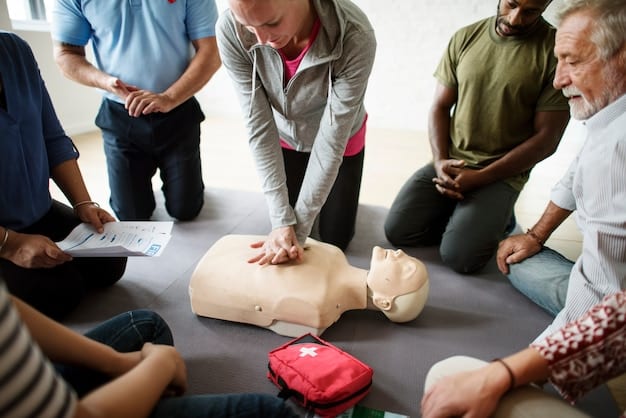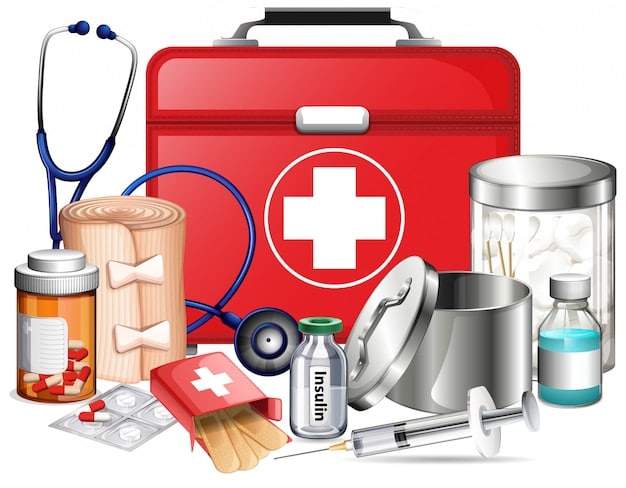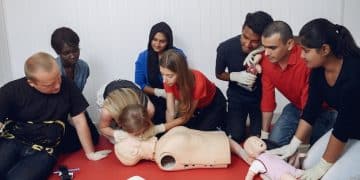Emergency Preparedness Week 2025: How to Be Ready

Emergency Preparedness Week 2025 is a crucial time to ensure you and your community are ready for unexpected events; it’s an opportunity to review your emergency plans, restock supplies, and learn how to respond effectively to various disasters.
Are you truly prepared for the unexpected? **Emergency Preparedness Week 2025: Are You Ready for the Unexpected?** is the perfect time to take stock, plan ahead, and ensure you and your loved ones are safe when disaster strikes. Discover how to prepare effectively!
Understanding Emergency Preparedness Week
Emergency Preparedness Week is an annual event dedicated to raising awareness about the importance of being prepared for emergencies. It serves as a reminder for individuals, families, and communities to take proactive steps to protect themselves and their properties.
The Purpose of the Week
The primary goal is to educate the public on the risks associated with various types of emergencies, from natural disasters to man-made crises. By promoting awareness and providing resources, the week encourages people to develop emergency plans and assemble necessary supplies.
Why It’s Important
Being prepared can significantly reduce the impact of an emergency. Having a plan in place and knowing what to do can save lives, minimize property damage, and facilitate a quicker recovery. It also helps reduce the burden on emergency services, allowing them to focus on those in immediate need.
- Review your emergency plan with your family.
- Check and replenish your emergency kit supplies.
- Learn basic first aid and CPR skills.
- Participate in community preparedness events.
During Emergency Preparedness Week, various organizations, including government agencies, non-profits, and community groups, host events and workshops to provide valuable information and resources. These events often include training sessions, demonstrations, and opportunities to connect with local experts.

Creating an Emergency Kit
One of the most crucial steps in emergency preparedness is assembling an emergency kit. This kit should contain essential items needed to survive for at least 72 hours without outside assistance. A well-stocked kit can make a significant difference in your ability to cope with an emergency situation.
Essential Items for Your Kit
When assembling your emergency kit, focus on the basics: water, food, first aid supplies, and communication tools. Each item should be carefully chosen to meet the specific needs of you and your family.
Water and Food
Water is the most critical element. Aim for at least one gallon of water per person per day. Non-perishable food items are also essential. Choose foods that are easy to store, require no cooking, and have a long shelf life, such as canned goods, energy bars, and dried fruits.
- Water: One gallon per person per day.
- Non-Perishable Food: Canned goods, energy bars, dried fruits.
- Manual Can Opener: Don’t forget this essential tool.
- Moist Towelettes, Garbage Bags and plastic ties : For personal sanitation.
In addition to food and water, your kit should include a first aid kit with essential medications, bandages, antiseptic wipes, and pain relievers. A flashlight and a battery-powered radio are also vital for staying informed during an emergency. Consider adding a whistle to signal for help if needed.
Creating an emergency kit can seem daunting, but it’s a manageable task if you break it down into steps. Start with the basics and gradually add more items as you are able. The most important thing is to have something in place before an emergency strikes.
Developing a Family Emergency Plan
Having an emergency kit is just one piece of the preparedness puzzle. Developing a comprehensive family emergency plan is equally important. This plan should outline what each family member should do in various emergency scenarios and ensure everyone knows how to communicate and stay safe.
Key Components of an Emergency Plan
Your family emergency plan should include designated meeting places, communication strategies, and evacuation routes. Tailor the plan to your specific needs and circumstances, considering factors such as your location, the ages of your family members, and any special needs or medical conditions.
Meeting Places and Communication
Establish primary and secondary meeting places in case you are separated during an emergency. The primary meeting place should be close to home, while the secondary meeting place should be outside your immediate neighborhood, in case your home is inaccessible. Ensure everyone knows how to contact each other using cell phones or other communication devices.
- Designated Meeting Places: Near home and outside the neighborhood.
- Communication Strategies: Cell phones, text messages, or a designated out-of-state contact.
- Evacuation Routes: Plan multiple escape routes from your home and neighborhood.
Regularly review and practice your family emergency plan. Conduct drills to ensure everyone knows what to do and where to go in different scenarios. Update the plan as needed to reflect changes in your family’s circumstances or new information about potential hazards.

Staying Informed During an Emergency
Staying informed is crucial during an emergency. Knowing what is happening and receiving timely alerts can help you make informed decisions and take appropriate actions to protect yourself and your loved ones. There are several ways to stay updated on emergency situations.
Reliable Sources of Information
Rely on official sources of information, such as government agencies, emergency management services, and local news outlets. These sources provide accurate and up-to-date information about the nature of the emergency, potential risks, and recommended actions.
Alert Systems and Apps
Sign up for local emergency alert systems to receive notifications via text message, email, or phone call. Many communities have specific apps that provide real-time information about emergencies and resources available to residents. Stay tuned to local news channels for detailed coverage of the situation.
- Emergency Alert Systems: Sign up for local notifications.
- Local News Outlets: Stay informed through TV, radio, and online sources.
- Emergency Management Agencies: Follow official guidance and instructions.
Avoid spreading rumors or unverified information on social media. Always verify information with official sources before sharing it with others. Misinformation can create panic and hinder effective response efforts.
Staying informed requires vigilance and a reliance on credible sources. By using multiple channels of communication and verifying information before sharing it, you can make informed decisions and contribute to a safer outcome during an emergency.
Community Involvement and Training
Emergency preparedness is not just an individual or family responsibility; it’s also a community effort. Getting involved in local preparedness initiatives and participating in training programs can enhance your skills and knowledge, while also strengthening your community’s overall resilience.
Joining Local Preparedness Groups
Many communities have volunteer groups or organizations dedicated to emergency preparedness. Joining these groups can provide opportunities to learn from experienced individuals, participate in drills and exercises, and contribute to community-wide planning efforts.
CERT Programs
Consider enrolling in a Community Emergency Response Team (CERT) program. CERT programs offer training in basic disaster response skills, such as fire safety, light search and rescue, team organization, and disaster medical operations. These skills can be invaluable in assisting your community during an emergency.
- Community Emergency Response Team (CERT): Train in basic disaster response skills.
- Local Volunteer Groups: Participate in community preparedness initiatives.
- First Aid and CPR Training: Acquire essential life-saving skills.
In addition to formal training programs, take advantage of opportunities to learn basic first aid and CPR skills. These skills can enable you to provide immediate assistance to injured individuals until professional help arrives. Many organizations offer affordable or free training sessions.
Community involvement and training not only enhance your preparedness but also foster a sense of unity and resilience. By working together, communities can better withstand and recover from emergencies.
Specific Emergency Scenarios and Responses
Different types of emergencies require different responses. Understanding the specific risks in your area and knowing how to react to various scenarios can significantly improve your safety and the safety of those around you. Some common emergency scenarios include natural disasters, such as hurricanes, earthquakes, and floods, as well as man-made crises, such as fires and chemical spills.
Natural Disasters
For each type of natural disaster, there are specific precautions to take. During a hurricane, secure your home, evacuate if necessary, and stay informed about the storm’s progress. In the event of an earthquake, drop, cover, and hold on. If you live in a flood-prone area, elevate your home and belongings and be prepared to evacuate quickly.
Man-Made Crises
In the case of a fire, evacuate immediately and call emergency services. For chemical spills, follow instructions from emergency responders and avoid contact with the substance. Shelter-in-place if instructed to do so, and seal off windows and doors to prevent exposure.
- Hurricanes: Secure your home and follow evacuation orders.
- Earthquakes: Drop, cover, and hold on.
- Floods: Elevate your home and be prepared to evacuate.
Having a clear understanding of the specific emergency scenarios that could affect your area, and practicing appropriate responses, can greatly enhance your ability to protect yourself and help others in times of crisis.
| Key Point | Brief Description |
|---|---|
| 🎒 Emergency Kit | Assemble a kit with water, food, first aid, and communication tools. |
| 🗺️ Family Plan | Develop a plan with meeting places, communication, and evacuation routes. |
| 📢 Stay Informed | Use official alert systems and local news for up-to-date information. |
| 🤝 Community Involvement | Join CERT or local groups to enhance skills and resilience. |
Frequently Asked Questions
▼
Emergency Preparedness Week is an annual event focused on raising awareness about the importance of being prepared for various types of emergencies, encouraging proactive measures.
▼
Your kit should include water, non-perishable food, a first aid kit, flashlight, battery-powered radio, and personal hygiene items to last at least 72 hours.
▼
Review your plan at least twice a year, and update it as needed to reflect changes in family circumstances or new hazard information to keep it current.
▼
Rely on official sources such as government agencies, emergency management services, and local news outlets for timely and accurate updates during an emergency.
▼
Join local preparedness groups, enroll in CERT programs, and take first aid and CPR training to enhance your skills and contribute to community resilience.
Conclusion
Emergency Preparedness Week 2025 presents a valuable opportunity to reassess and enhance your readiness for unexpected events. By taking proactive steps to create an emergency kit, develop a family emergency plan, and stay informed, you can significantly improve your ability to protect yourself and your community during times of crisis.





